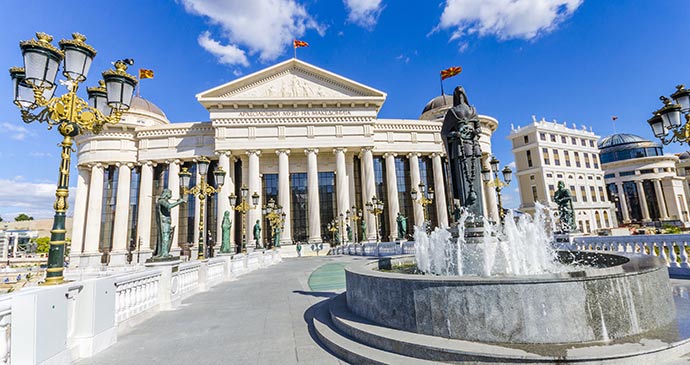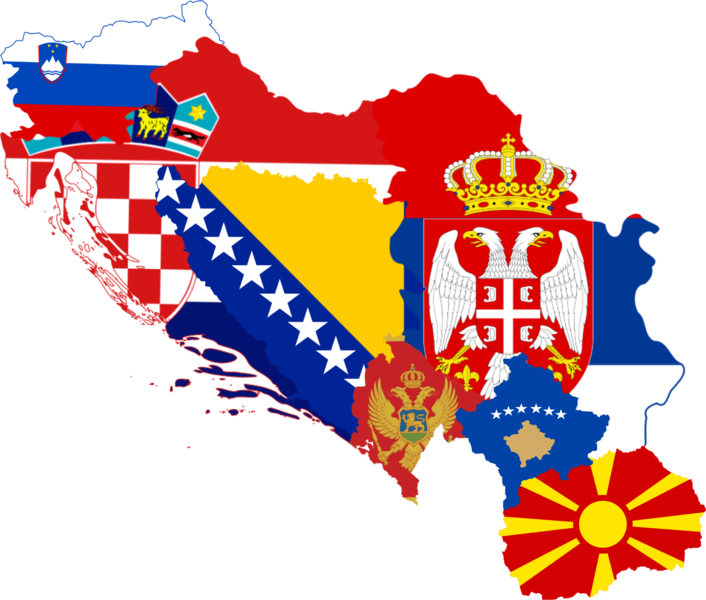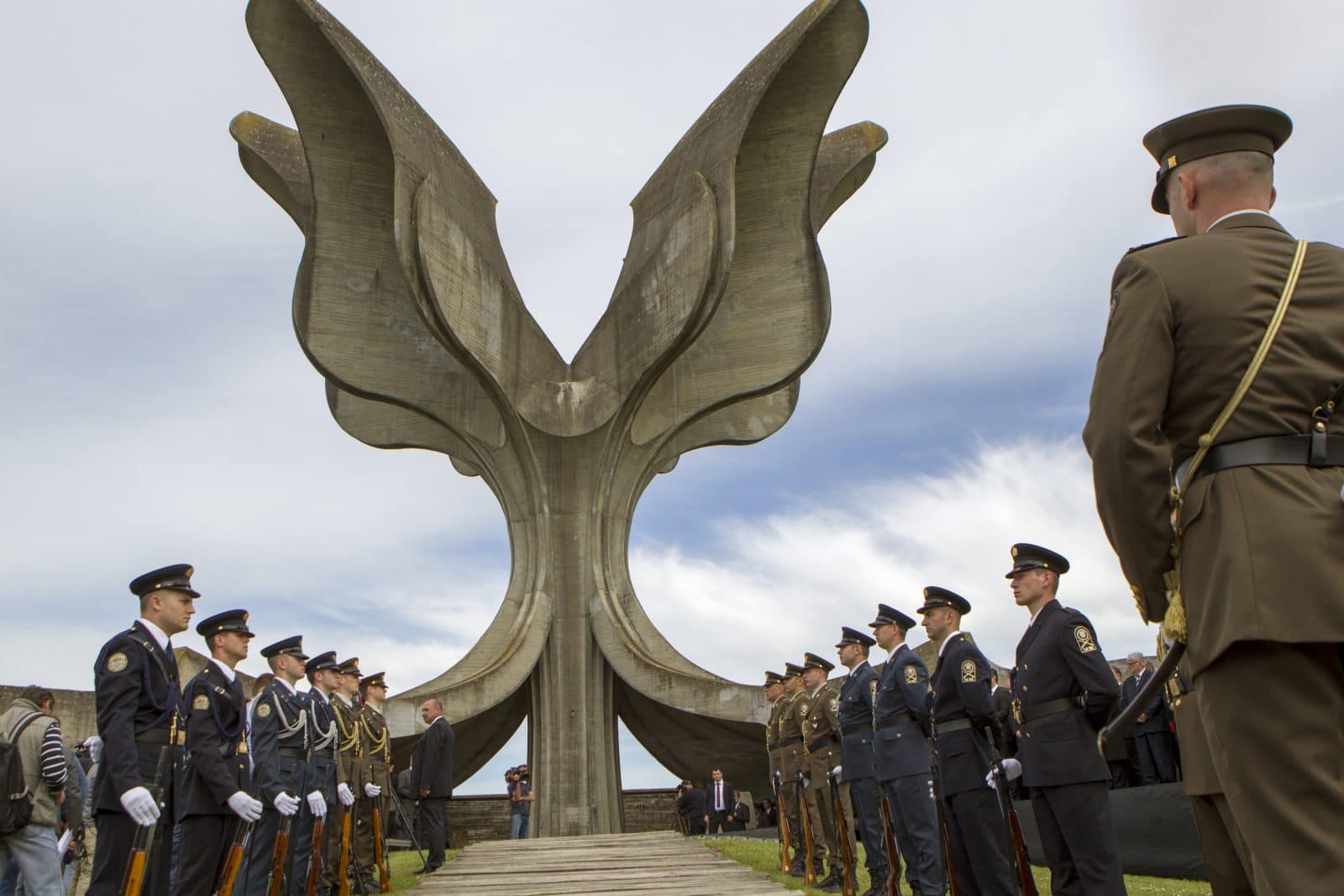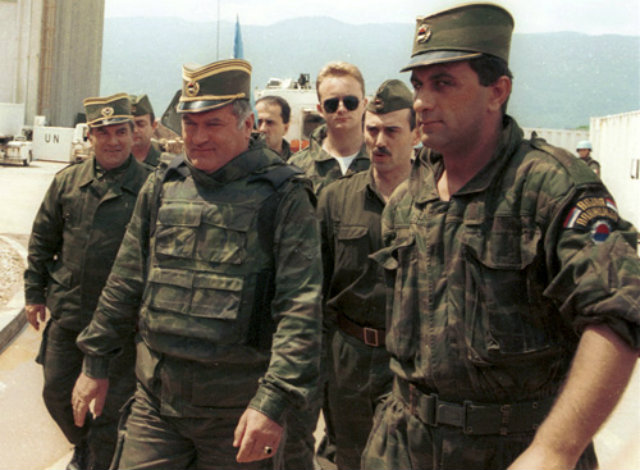
Views: 563
The brutal destruction of ex-Yugoslav Federal state-system was in a form of the civil wars or, in another word, a chain of violent conflicts from 1991 to 1995. From the spring of 1992, the SFRY already did not exist as a state and, therefore, the conflicts were turned into the Wars of the Yugoslav Succession.

The Yugoslav civil wars can be comprised of the three closely related armed conflicts:
1) War in Slovenia in 1991.
2) War in Croatia from 1991 to 1995.
3) War in Bosnia-Herzegovina from 1992 to 1995.[i]
In the year of 1990, the real potential for the armed conflict became quite obvious. At that time, the country was already affected by both economic and financial crisis and confronted by tremendously rising nationalism and ethnic rivalries among all biggest national and confessional groups and their respective republics. On one hand, the exact and precise causes of the resulting civil wars were complex and historically deeply rooted, on another hand, they were characterized by interlinked ethnic and confessional struggles which were involving the greatest part of the Yugoslav population but primarily the Serbs, the Croats, and the Bosniaks. In Bosnia-Herzegovina, the main conflict was between the Serbs and the Bosniaks but to complicate the issue, fighting and atrocities took as well as a place between the Croats and the Bosniaks followed by separate series of violence between rival Bosniak groups. Nevertheless, in order to win public support, nationalist leaders became engaged in psychological warfare and propaganda that the destruction of common Yugoslav state was quite necessary for the creation of nation-states and, therefore, better life.[ii]
A new 1991 year started with a fear of the escalation of the political conflicts into a real war as on January 9th the Yugoslav collective Presidency issued order to disarm all paramilitary formations but firstly aimed at those in Croatia, especially the HDZ party’s militia – the Rally of National Guard (the ZNG). In neighboring Bosnia-Herzegovina at the same time started a year-long commemoration of the Serb victims of WWII on the territory of the Independent State of Croatia, organized by the Serbian Orthodox Church. On January 25th the Presidency of the SFRY, despite the frustration by Serbia and Montenegro, passed decision not to permit military intervention by the YPA in Croatia what was de facto recognition of the end of Yugoslavia. On the same day, the People’s Assembly of Macedonia (Sobranie) issued the Declaration of Sovereignty and Independence without any reaction from Belgrade.
The further killing of Yugoslavia came from Zagreb where the Croatian Parliament on February 21st issued a proclamation that Croatia’s law has superiority over the Yugoslav legislation, and at the same time adopted the resolution on initiating the procedure of secession from Yugoslavia. However, Croatia’s Serbs reacted immediately as on February 28th Serb National Council of Serb Autonomous Region of Krayina adopted the Declaration on Separation from Croatia remaining within the state of Yugoslavia. The first massive exodus of civilians happened on March 4th when several thousands of Serbs took refuge in Serbia from the Danube basin in Croatia as they were threatening with massacres by the Croat ZNG and other paramilitary formations which were using WWII Ustashi slogans, insignias and uniforms.[iii] On March 12th and 13th, there was failed attempt at the extraordinary session of the SFRY Presidency to declare a state of emergency followed by the proclamation of independence of the Serb Autonomous Region of Krayina in Croatia on March 15th. On next day, President of Serbia announced that “Yugoslavia is finished”. On March 31st the Croatian regular police attacked Serbian villages around Plitvice but were fired back by local Serbian defense units (one Croat policeman – Josip Jović and one Serb – Rajko Vukadinović were killed with injuries on both sides). Basically, on this day the civil war in Yugoslavia started from a technical point of view.[iv] On May 2nd twelve Croatian policemen were killed by the Serbian territorial defense forces in the village of Borovo Selo near Vukovar as they attempted to occupy the village and commit massacre over local Serbs.
The final process of Croatia’s secession from Yugoslavia took place on May 19th when Tudjman’s Government organized a referendum in Croatia on the independence which was boycotted by the Serbs. In order to formally try to save some kind of Yugoslavia, the Bosnian-Herzegovinian President Alija Izetbegović and the Macedonian President Kiro Gligorov proposed asymmetric (graduated) federation as a solution to the crisis but it was too late to save the country even after a meeting between Izetbegović, Tudjman and Milošević in Split on June 12th. Three days later (June 15th) the official delegations of Croatia and Slovenia met in Ljubljana to agree on mutual harmonization of the coming political moves toward a formal proclamation of independence and secession from the rest of Yugoslavia. Finally, the Parliaments of both Slovenia and Croatia proclaimed formal sovereignty and independence on the same day – June 25th regardless of the warning by the US Secretary of State James Baker that Washington opposes both Slovenian and Croatian independence as well as the use of force by the Yugoslav Government for the sake to preserve the SFRY.
The end of results of the renewed nationalisms among the Yugoslavs in the 1970s and the 1980s, propagated firstly by the nationalistic dissidents (like Tudjman and Izetbegović) and finally by newly formed nationalistic political parties was the destruction of Yugoslavia as a common homeland of the South Slavs (except the Bulgarians) in the 1990s. Instead of it, there were created separate nation-states for each ethnic group followed by the ethnic cleansing of the others. The dissident national ideologues of the 1970s and the 1980s, like their the 19th-century predecessors, drawn up mutually quite incompatible maps of their desired nation-states as on such imagined maps, different united nation-states claimed in many cases the same territories.[v] As a matter of fact, in order to realize in the practice such maps, it was quite necessary for the advocates of those contesting ideologies to win political power in their respective republics and/or regions that was exactly happened in 1990 as a consequence of multi-party elections in all six republics of ex-Yugoslavia. In essence, what started as an ideological contest over territory, in the 1990s was turned into the civil wars over the same territories. The focal aim of these wars was to establish several united nation-states on the lands often inhabited by an intermixed ethnic and confessional group of peoples. But in the ethnically and religiously overmixed territories, the founding of unified nation-states by the military means, in fact inevitably, led to the forced expulsion or elimination of those who did not belong to the “proper” national group and, therefore, in all such problematic territories in which the conflict existed, the members of one or more ethnic or confessional groups became victims. For instance, in 1991 the Croatian civilians were expelled from the Serb-controlled territories in Tudjman’s Croatia but at the same time, the Serb civilians were expelled from their homes across Croatia. In the spring of 1992, the Serb paramilitary forces expelled the Bosnian-Herzegovinian Muslim civilians from the eastern parts of the republic but in 1995 the combined forces of Muslims and Croats forced the Serb civilians to leave West Bosnia-Herzegovina as they succeeded to occupy it with the great support of the US Clinton administration. The Croat paramilitary detachments with a help of regular Croatia’s army evicted first the Serbian civilians from West Herzegovina in 1992, and later the Bosniaks as well (for instance, the infamous case of the Bosniak populated Ahmići village). However, during the military conflict between the Croats and the Bosniaks in Central Bosnia-Herzegovina in 1993‒1994 many local Croats were expelled from their homes. The Croats, too, turned on Bosnian-Herzegovinian Bosniaks, seizing large areas around Mostar – a city which experienced months of heavy artillery bombardment by the Croat forces[vi] which started on May 9th, 1993 a general attack on the Muslim East Mostar, systematically destroying this part of the city. They expelled the Bosniaks from West Mostar which was under the Croat control or deported them to the concentration camps (Heliodrom near Mostar, Dretelj, Gabela, Ljubuški) where they were starved, tortured and killed. The mid-16th-century Old Bridge in Mostar over the River Neretva was destroyed by the Croat forces on May 9th, 1993.
The final destruction of Yugoslavia started when on June 25th, 1991, at the time of the general collapse of the Communist regimes in East-Central and South-East Europe, Slovenia and Croatia declared their independence from the Yugoslav federation to be recognized by the international community. The same did Macedonia in September 1991 followed by Bosnia-Herzegovina in October of the same year. However, Serbia and Montenegro continued to identify themselves as parts of (shorten) Yugoslavia and established a new federation in April 1992 (until 2006). Their combined territory and population represented around 40 per cent of the former-Titoslavia.[vii]
The civil war and violence which became as a consequence of the political propaganda and electoral campaigns of the new national and nationalistic political parties across Yugoslavia were quite predictable in the terms of the national ideologies advocated by those parties and party’s leadership. Whoever opposed such ideologies became labeled as a foreign enemy or/and political instrument of such an enemy real or imagined. But the focal issue became an idea that to use a force, on legal or not way did not matter, against foreign enemies and their “inner fifth column” was not only legitimate and justified but as well as necessary. Subsequently, the political post-elections’ leaders in Yugoslavia proceeded to struggle against all of those whom they labeled as foreign enemies and their domestic collaborators. For instance, the new Croatia’s Government (with old WWII Ustashi ideology and iconography) and its security and paramilitary detachments (in many cases dressed in the Ustashi uniforms or having Ustashi insignias) became the foreign enemy of the Serb Krayina regional political leaders, while, at the same time, the Serb Krayina leaders and their militias were, for the Croatian Government, instruments of the foreign Government in Belgrade. After June 25th, 1991, the YPA formations in Slovenia and Croatia were officially declared by Ljubljana and Zagreb as a foreign occupying force what happened the same for Bosnia-Hercegovina’s Muslim Government next year too.[viii]
On March 1st‒2nd, 1992, in a referendum which was boycotted by Bosnian-Herzegovinian Serbs, more than 60 per cent of Bosnian-Herzegovinian citizens voted for an independence – practically the Croats and the Bosniaks (at that time officially called as the Muslims) and, therefore, gave a formal legitimacy to the political move when the Bosnian-Herzegovinian Croat and the Bosniak representatives in the Parliament in Sarajevo proclaimed an independence of Bosnia-Herzegovina already on October 15th, 1991 and, as a consequence, broke the previous political deal with the Serbs. However, the proclamation of independence was after the referendum results followed by its recognition by the European Community (today the European Union) on April 6th, 1992[ix] forcing at such a way the Bosnian-Herzegovinian Serbs to rebel on the same day with the focal aim to separate their own ethnographic territory what they formally did by their own political proclamation on the night between April 5th and 6th, 1992 under the name of the Serbian Republic of Bosnia-Herzegovina (capital in Sarajevo) but soon (on August 12th, 1992) renamed into the Republic of Srpska which was recognized by nobody in the world including the FRY as well.
The territory of Republic of Srpska (capital in Pale nearby Sarajevo) was finally bordered till December 1992 being composed of almost 70 per cent of Bosnia-Herzegovina primarily due to overwhelming military superiority of the Bosnian-Herzegovinian Serbs based on comprehensive support of neighboring Serbia. However, the Bosnian-Herzegovinian Croats soon followed the Serb example, rejecting the authority of the central Bosnian-Herzegovinian Government and declaring their own Republic of Herzeg-Bosnia (capital in Mostar in West Herzegovina) on July 5th, 1992 with the full backing of neighboring Croatia. For the Croats, the Republic of Herzeg-Bosnia was nothing else but, in fact, “South Croatia”.[x] Furthermore, the Muslims (Bosniaks) in West Bosnia (Cazinska Krajina) proclaimed first their own autonomous region (Autonomous Province of West Bosnia) and later on July 26th, 1994 an independent Republic of West Bosnia (capital in Velika Kladuša) being at that time not under the real control of the central Government in Sarajevo. The conflict in Bosnia-Herzegovina soon after Western countries recognized its formal sovereignty turned into a bloody three-sided inter-ethnic civil war for the territories, with civilians of all ethnicities becoming victims of unprecedented crimes after WWII in Europe.[xi]
The Yugoslav civil wars of the 1990s ended in several stages and in differing ways from the military pressure and intervention to diplomacy and negotiations. Nevertheless, what they shared in common were two points of their ultimate results:
1) International recognition of newly proclaimed independent and sovereign states instead of a single Yugoslavia.
2) Massive economic disruption to all successor states which in the cases of Bosnia-Herzegovina and Serbia resulted in significant failures of these states.
As the formal day of the end of a “Greater” Yugoslavia, it can be considered April 27th, 1992 when the Federal Republic of Yugoslavia (the FRY) was proclaimed in Belgrade instead of it. This “Shortened” Yugoslavia was composed just of two ex-Yugoslav republics: Montenegro and Serbia (with Kosovo-Metochia and Vojvodina). The process of military destruction of ex-Yugoslavia was formally ended by signing the Dayton Accord on Bosnia-Herzegovina on November 21st, 1995. In October 1995, a ceasefire agreement was reached in Bosnia-Herzegovina under the US pressure, and the leaders of three nations in conflict agreed to attend a peace conference in Dayton (Ohio, the USA) in November. The accord was covering ethnopolitical entity borders, electoral procedures, instruments for the protection of human rights, and return of refugees and displaced persons. Two ethnopolitical entities (the Bosniak-Croat Federation and the Republic of Srpska) within Bosnia-Herzegovina would function as a state by having joint institutions of two-chamber Parliament, three-member Presidency, Council of Ministers, Constitutional Court, and Central Bank.[xii]
The Yugoslav conflicts in the 1990s are usually referred in the West as the deadliest violence and wars in Europe since 1945 due to the severity and intensity of the struggle followed by brutal ethnic cleansing, war crimes and elements of genocide. These conflicts, surely, have been the first ones since WWII to be officially labeled as genocidal in character by Western part of the international community which, by the way, fueled these conflicts until their ends especially Germany and the USA. Nevertheless, the bloody destruction of ex-Yugoslavia created a higher interest in the phenomena of “clash of civilization” promoted by Samuel P. Huntington[xiii] as it was advocated an idea that the Yugoslavs have been “at the ‘fault line’ of three civilizations – the Serb, Croatian, and Bosnian Muslim”,[xiv] i.e., the Eastern Christianity, the Roman Catholicism, and Oriental Islam. Finally, the case of ex-Yugoslavia confirmed the idea that fault lines between clashing civilizations are, in fact, the battle lines of the new post-Cold War New Order.
www.global-politics.eu/sotirovic
sotirovic@global-politics.eu
© Vladislav B. Sotirovic 2019
Endnotes:
[i] Jeffrey Haynes et al., World Politics, New York: Routledge Taylor & Francis Group, 2011, 587.
[ii] Susan L. Woodward, Balkan Tragedy: Chaos and Dissolution after the Cold War, Washington, D. C.: The Brooking Institution, 1995, 228.
[iii] According to the Serbian claims, there were already up to 40,000 Serbian refugees from Croatia in Serbia before Croatia’s declaration of independence on June 25th, 1991.
[iv] Вељко Ђурић Машина (уредник), Република Српска Крајина десет година послије, Београд: Добра воља, 2005, 21.
[v] About this issue, see in [Vladislav B. Sotirović, “Emigration, Refugees and Ethnic Cleansing in Yugoslavia 1991–2001 in the Context of Transforming Ethnographical Borders into National-State Borders”, Dalia Kuizinienė (ed.), Beginnings and Ends of Emigration: Life without Borders in Contemporary World, A collection of scholarly essays, Kaunas: Versus Aureus, 2005, 85–108].
[vi] Richard W. Mansbach, Kirsten L. Taylor, Introduction to Global Politics, Second Edition, London−New York: Routledge Taylor & Francis Group, 2012, 443.
[vii] Richard Frucht (ed.), Encyclopedia of Eastern Europe from the Congress of Vienna to the Fall of Communism, New York‒London: Garland Publishing, Inc., 2000, 871.
[viii] Aleksandar Pavković, “National Liberations in Former Yugoslavia: When Will They End?”, East European Quarterly, XXXVI, № 2, 2002, 241.
[ix] Branka Magaš, Ivo Žanić (eds.), The War in Croatia and Bosnia-Herzegovina 1991‒1995, London‒Portland, OR: Frank Cass, 2001, 361.
[x] Jelena Guskova, Istorija jugoslovenske krize 1990−2000, I, Beograd: IGAM, 2003, 368−370.
[xi] Andrew Heywood, Global Politics, New York: Palgrave Macmillan, 2011, 178.
[xii] Branka Magaš, Ivo Žanić (eds.), The War in Croatia and Bosnia-Herzegovina 1991‒1995, London‒Portland, OR: Frank Cass, 2001, 376.
[xiii] Harvard University’s political scientist Samuel P. Huntington published in 1993 an article in the journal Foreign Affairs entitled “The Clash of Civilizations?” See also [Samuel P. Huntington, The Clash of Civilizations: Remaking of World Order, New York: Simon & Schuster, 1996].
[xiv] Richard W. Mansbach, Kirsten L. Taylor, Introduction to Global Politics, Second Edition, London−New York: Routledge Taylor & Francis Group, 2012, 445.

Origins of images: Facebook, Twitter, Wikimedia, Wikipedia, Flickr, Google, Imageinjection & Pinterest.
Read our Disclaimer/Legal Statement!
Donate to Support Us
We would like to ask you to consider a small donation to help our team keep working. We accept no advertising and rely only on you, our readers, to keep us digging the truth on history, global politics and international relations.












